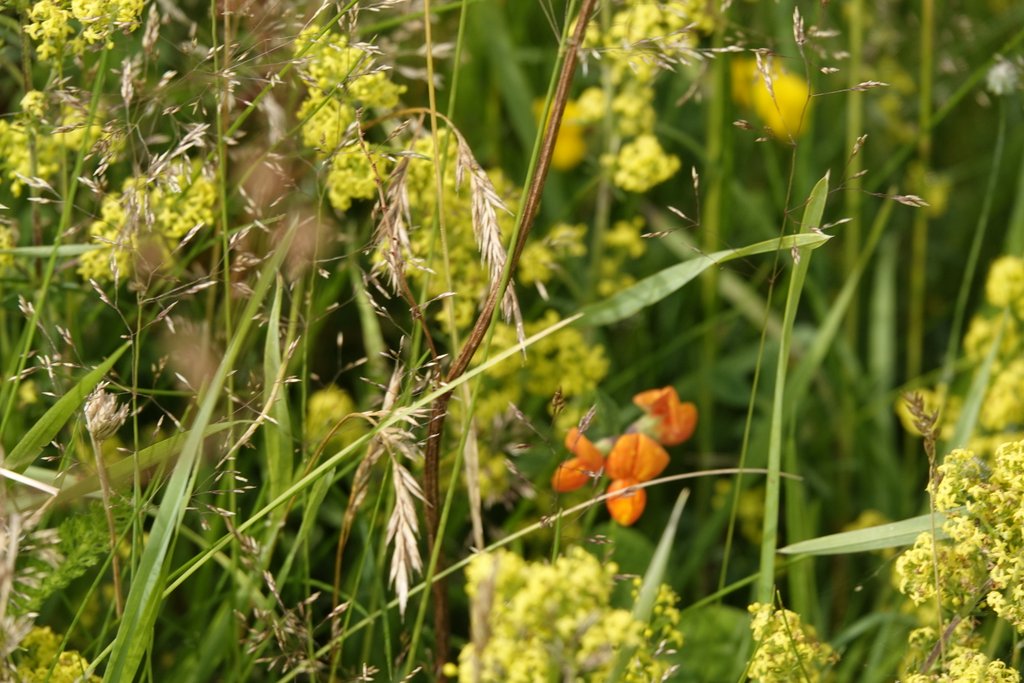Quick Links
To report a problem on a verge…
you can report it using the “love clean streets” app
or directly to ESCC 
To apply for designation on a verge contact East Sussex Highways below
“Verge” – a grass border along a road
Who owns the verges? ESCC are responsible for cutting the verges. A verge normally adjoins the highway (and possibly the pavement).
A few years ago, Seaford Town council was informed of East Sussex County Council’s decision to reduce the number of annual verge cuts from six cuts a year to two a year, and many residents have appreciated the longer grass and the flowers and insects that follow. Across the UK if verges were cut less, it would be the equivalent of creating a new wildlife habitat the size of Dorset.
Obviously some verges do need to be kept short for safety reasons, especially at road junctions, and where people need to walk.
If you are concerned for example that long grass is making a junction dangerous or a pavement impassable you can get in touch with ESCC and ask them to cut it. You can report verges that are causing a hazard, and other problems in your local environment here or by using the LoveCleanStreets app.
On the Verge are working with councils and councillors towards improved biodiversity in our green spaces and verges. We also want to ensure that the verges work for the people of Seaford keeping streets accessible and safe for all.
We are also working to educate and inspire the wider public why it is so important to improve biodiversity in verges, green spaces and gardens, rather than keeping verges “tidy” with a monoculture of only grass. Wildlife urgently needs these “corridors” of habitat so that it can flourish.
Grass verges – a closer look
It’s incredible just how quickly flowers can start to appear in grass verges. Some seeds can lay in the soil for many years waiting for a chance to sprout. Other seeds blow in or are carried by insects or birds. The soil type will often determine the type of flower that appears. For example some of the hilly streets in Seaford (such as Hawth Hill) are built over chalk grassland – a very precious and diverse habitat. Other verges will vary depending on whether it is in sun or shade, well drained/watered or enriched by mulching (or even dogs!)
Often the least interesting thing about a verge is the grass as this is often a common rye grass. With ideal conditions (rain/sunshine and improved soil) this grass can really shoot up as we saw in the Spring of 2023. This has understandably caused many people to complain, that the verges are too long for safety, look messy, and spread grass seeds everywhere.
The current maintenance regime of two cuts a year is not ideal for encouraging biodiversity. The cuttings are left in situ which means the nutrients return to the soil, leading to more vigorous and coarser grass, to the detriment of any wildflower growth. Ideally all the cuttings should be removed, which requires different machines to collect and dispose of the arisings.
We would love to see more fine grasses and wild flowers appearing in our town and encourage everyone to get out and see what is growing in your verges!
“Verge” to move in a specified direction
The main reason that the verges are now only mowed twice a year is to save money, and money is the reason given that our council cannot “collect” and dispose of the cuttings.
Dorset County Council provides an excellent example of how to manage verges differently, principally by relying on the cut and collect method on established verges. See their website for more details
Apart from wildlife benefits, they have seen a significant reduction in maintenance costs long-term, and a much neater and tidier appearance when the verges are cut. Their report “Guidance sheet road verges’’, details how their approach has led to savings of “c. £100k in 2015/16 and 2016/17, and a further saving of £50k in 2017-18.” Such savings allowed the redeployment of “in-house verge teams to other highway tasks such as maintaining Rights of Way.’’
We hope that our local verges could also benefit from this approach, once the current maintenance contracts end. If you agree, please write to your local councillors to support this long term approach.
Your verge
What can you do if you want to bring more wildlife to “your” verge?
You may be surprised to know that the verges outside your house along the roadside do not belong to you. All the verges in Seaford are the responsibility of ESCC.
Legally, you’re not allowed to do any work on the verge outside your house – even mow it – without permission from the council and without supervision from a qualified person. At first sight, this might seem over-the-top, but some verges are close to busy roads, and near dangerous junctions. Even though the rules seem restrictive, the aim is to keep people safe.
Although East Sussex County Council only mows the verges twice a year in Seaford, they are required to keep grass short if there is a safety reason. See above how to report any issues.
It is possible for some verges to be managed differently – as Wildlife or Meadow Verges. Find out more about how to do this here.
This page is managed by On the Verge. Please get in touch if you would like to write content for this website.











